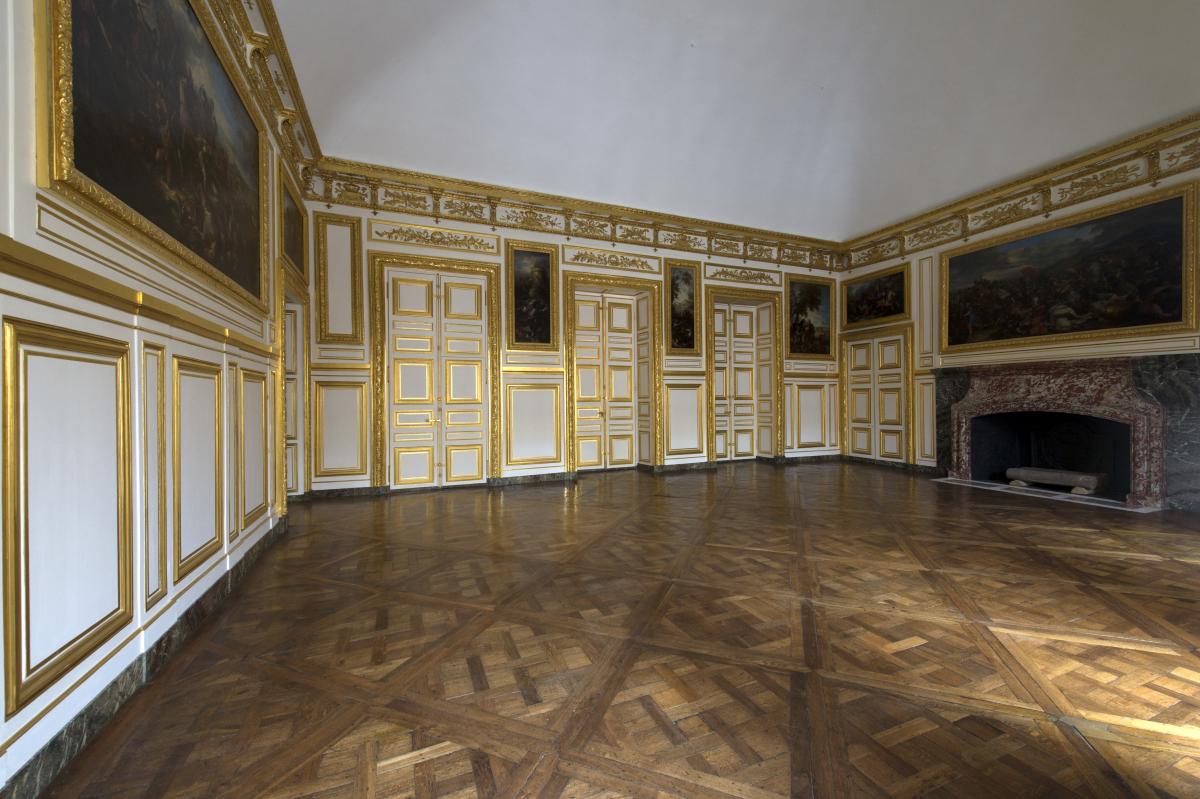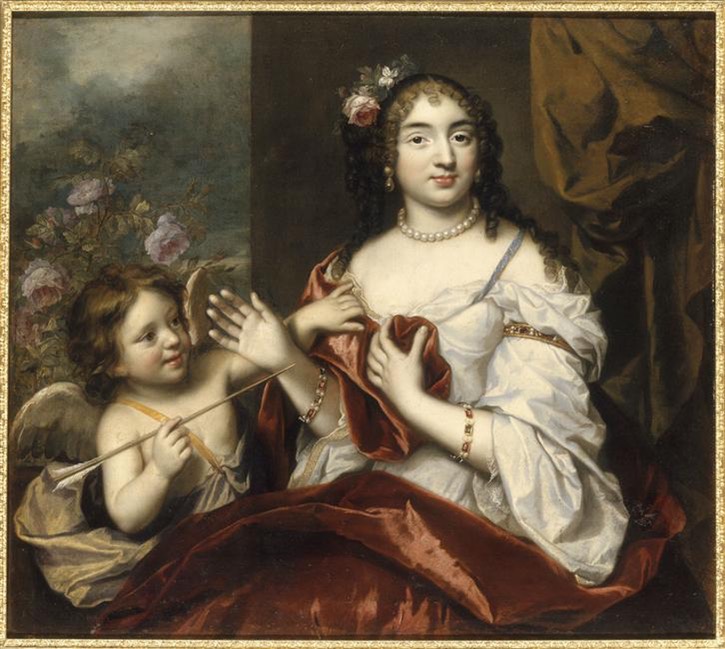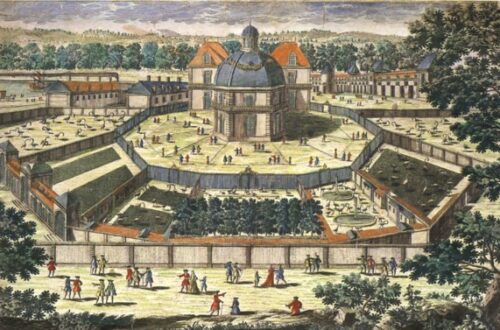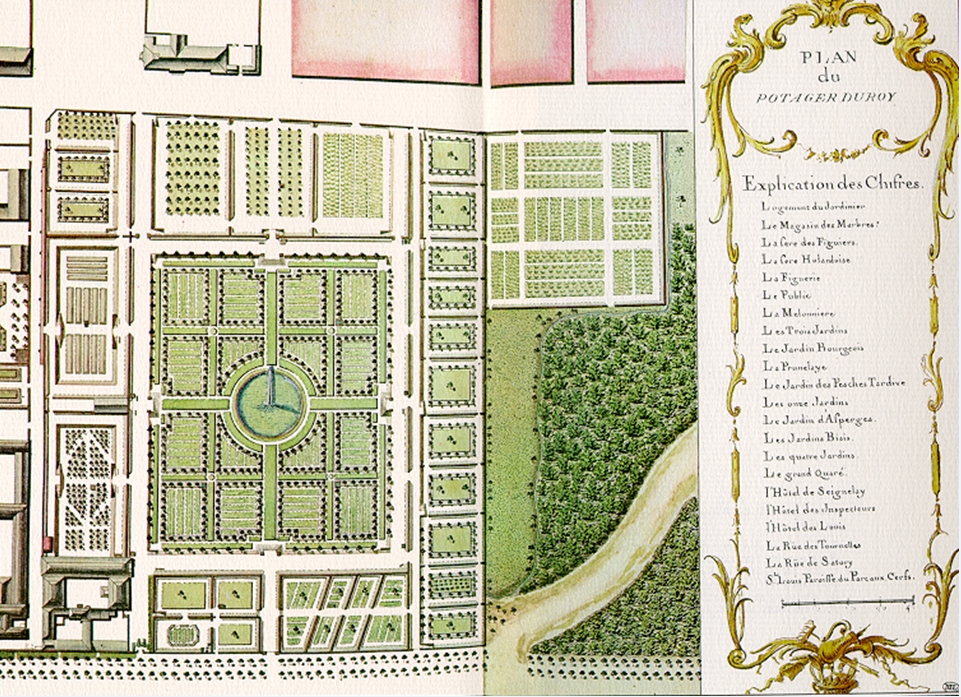Le Appartement du Roi
The more private version of the Grand Appartement du Roi, faces the cour de marbre and served as the living quarters of Louis XIV. While the Grand Appartement was open to the nobles during the day and certain evenings, getting into the Appartement du Roi was an entirely different matter. Who could enter and proceed how far was strictly regulated, while today we (humble peasants) can even go into the council chamber where the Sun King sat down to make politics.
Originally, it was a suite of eight rooms, but reduced to seven after 1701 and to six in 1755, which could be reached via the escalier de la reine. A Vestibule, panelled in marble and with windows to the cour royale, served as entrance to the Appartement du Roi, as well as to the Grand Appartement de la Reine and the apartment of Madame de Maintenon.

As customary in all royal residences, the Salle des Gardes du Roi was the first one in line. Here the Garde du Corps du Roi watched over who entered in shifts. The guards changed every twenty-four hours and at night the room was full with makeshift beds for them, which during the day were hidden behind folding screens. The room is remarkably unspectacular in its decoration compared to the rest of the royal rooms. The little decoration there is, depicts scenes of battle. Like the painting above the fireplace, it shows the guards in action. During Louis XIV’s time, the room also featured two large chandeliers emblazoned with the King’s monogram and several wooden benches. Each Monday, the room was cleared and a large table with a gold-fringed velvet rug placed in its centre on which the King in person accepted petitions from his subjects.

In the Première Antichambre, also called Salon du Grand Couvert, the decorations become a bit more elaborate again. Scene of battles decorate the walls here as well, but there is a bit more gold along them. Three windows face the cour de marbre and another three the cour de la reine to the south. After the death of the Queen and that of the Dauphine, Louis XIV took his public evening meals here at a table in front of the fireplace.

The Salon de l’œil de bœuf, named after the circular window on the southern side, is the main antechamber to the King’s Bedroom. The room was originally divided into two by a partition wall and was part of the Grand Appartement de la Reine. After the Queen’s death, the Sun King claimed them for himself and one part of the room served as antechamber, while the other was the King’s bedroom with the bed being placed in the left corner next to the fireplace. The bedroom part was a little small and Louis got a bit frustrated that it had no space for all the people who had to attend his lever and coucher. Thus the wall was knocked down in 1701 and the bedroom moved into the adjoining room, which previously was used as salon. The decoration of the room seems more Louis XV than Louis XIV. While the State Apartments have plenty of marble, Louis XIV developed a bit more simple taste as he grew older and this can be seen here.

The Chambre du Roi, Louis XIV’s bedroom, is located in the very centre of the palace and measures 90m². Where now the King’s bed stands, where three large doors that opened into the Hall of Mirrors. Those were closed off as the bed chamber was installed, the last building project of Louis XIV. A stucco by Nicolas Coustou showing France watches over the King as he slumbers. The paintings in the room were chosen by the Sun King himself; the authors of the gospels and The Tribute to Caesar by Valentin de Boulogne; Hagar in the wilderness by Giovanni Lanfranco; Saint John the Baptist by Giovanni Battista Caracciolo; Mary Madeleine by Domenico Zampieri; and two portraits in the style of Van Dyck. A bust of Louis XIV, made by Antoine Coysevox, sits on the mantelpiece of the fireplace. The hangings of the bed and the walls of the alcove are not the originals. The original alcove and bed hangings were restored in 1736, but in 1785 Louis XVI ordered the brocade burned in order to make use of the gold thread in them. He obtained over 60 kilograms of gold. The pattern of the current hangings is not the original either, but still rather fabulous. As it was decided to restore the hangings, the papers with the original pattern could not be located and the tenture d’hiver pattern, which decorated the Queen’s bedroom during winter, was used. The papers with the original pattern was found as the work had already began and it was thus carried on with the tenture d’hiver pattern. It was the balcony of Louis XIV’s bedroom, on which Louis XVI and Marie-Antoinette showed themselves to the raging mob outside the palace.

The Cabinet de Conseil in its current form dates back to 1755 and looked a bit different during the reign of Louis XIV. The Sun King’s Cabinet de Conseil was constructed around the same time as the Salon de la Guerre, because this salon dedicated to War took over what was the Salon de Jupiter and used to be the council chamber. In 1755, Louis XIV’s council chamber and an adjoining private salon, used by the King to enjoy some private time with his family, were combined to form the present Cabinet de Conseil. The Sun King’s council chamber reflects his personal tastes. While the walls were panelled with rather expensive mirrors, and the room thus renamed Cabinet des Glaces, the furniture was not too elaborate. A large velvet covered council table was placed in the middle and around it three arm-chairs as well as twelve folding chairs, along with a day-bed, which Louis used as he suffered of Le Royale.
The last room of the Appartement du Roi was the Cabinet des Termes, as mentioned, is now destroyed and a part of the current council chamber. It took its name from the twenty Hermes that were featured in the decor and was also called Cabinet des Perruques, because it hosted the King’s wigs. This room served as a sort of changing room for Louis XIV, when it was time to change shirt, wig or coat, often several times during the day. In the evenings, the Sun King met with his children, family or selected courtiers there.




